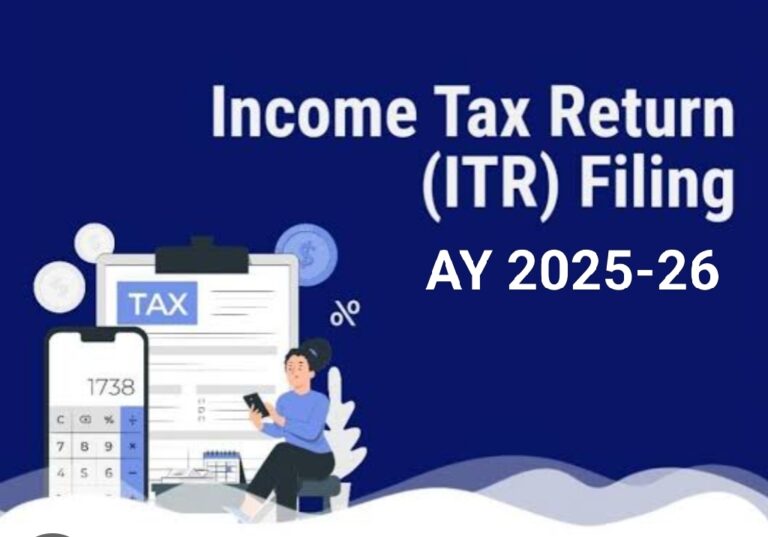Income Tax Return Filing 2025: With the ITR filing season for Assessment Year (AY) 2025-26 already underway, salaried employees, freelancers, and professionals are once again faced with the crucial decision — Should I opt for the old tax regime or the new tax regime?
While the new tax regime has become the default option from FY 2023-24, taxpayers still have the flexibility to choose the regime that offers maximum tax benefits based on their income structure and eligible deductions.
If you’re confused about which regime suits you best, here’s a comprehensive, updated comparison to help you decide.
What is the Old Tax Regime?
The old tax regime continues to be popular among taxpayers who can claim multiple exemptions and deductions. It allows individuals to lower their taxable income by availing benefits under sections like:
✅ Section 80C – Investments in PPF, ELSS, LIC premiums, etc. (up to ₹1.5 lakh)
✅ HRA (House Rent Allowance)
✅ LTA (Leave Travel Allowance)
✅ Home Loan Interest – under Section 24
✅ Section 80D – Health Insurance Premium
✅ Section 80E – Education Loan Interest
✅ Standard Deduction – ₹50,000 for salaried individuals
Old Tax Regime Slabs for FY 2024-25 (AY 2025-26):
| Income Slab | Tax Rate |
|---|---|
| Up to ₹2.5 lakh | Nil |
| ₹2.5 lakh – ₹5 lakh | 5% |
| ₹5 lakh – ₹10 lakh | 20% |
| Above ₹10 lakh | 30% |
💡 Note: A rebate under Section 87A is available for taxable income up to ₹5 lakh, resulting in zero tax liability for eligible individuals.
What is the New Tax Regime?
Introduced in Budget 2020 and revamped in Union Budget 2023, the new tax regime offers lower tax rates but limits most deductions and exemptions. From FY 2023-24 onwards, it became the default tax regime, offering a simplified tax structure.
New Tax Regime Slabs for FY 2024-25 (AY 2025-26):
| Income Slab | Tax Rate |
|---|---|
| Up to ₹3 lakh | Nil |
| ₹3 lakh – ₹6 lakh | 5% |
| ₹6 lakh – ₹9 lakh | 10% |
| ₹9 lakh – ₹12 lakh | 15% |
| ₹12 lakh – ₹15 lakh | 20% |
| Above ₹15 lakh | 30% |
✅ From FY 2023-24, salaried and pensioners also get a standard deduction of ₹50,000 under the new regime.
Old vs New Tax Regime: Key Differences
| Feature | Old Tax Regime | New Tax Regime |
|---|---|---|
| Tax Rates | Higher | Lower |
| Exemptions & Deductions | Allowed (80C, HRA, etc.) | Mostly Not Allowed |
| Standard Deduction | ₹50,000 | ₹50,000 (from FY 2023-24) |
| 87A Rebate | Up to ₹5 lakh income | Up to ₹7 lakh income |
| Default Regime | No | Yes (from FY 2023-24) |
| Best Suited For | Taxpayers with high deductions | Individuals with few/no deductions |
Who Should Choose the Old Tax Regime?
The old tax regime is ideal for individuals who claim significant tax deductions and exemptions. You may benefit from the old regime if:
✔️ You claim large deductions under Section 80C, 80D, or home loan interest
✔️ Your employer provides components like HRA, LTA, or reimbursements
✔️ You invest in tax-saving options like PPF, ELSS, or NSC
✔️ You are a senior citizen availing multiple deductions
Example:
Suppose your gross income is ₹10 lakh and you claim deductions of ₹2.5 – ₹3 lakh under eligible sections. Your taxable income reduces to around ₹7 lakh, making the old regime more tax-efficient.
Who Should Choose the New Tax Regime?
The new tax regime suits those who prefer simplicity and do not claim many deductions. It is suitable for:
✔️ Salaried individuals without major deductions
✔️ Freelancers, gig workers, and those with simplified income structures
✔️ Young professionals who haven’t made tax-saving investments yet
✔️ Individuals seeking lower tax rates and minimal documentation
Example:
A salaried individual earning ₹9 lakh with no significant deductions may pay less tax under the new regime, thanks to lower slab rates and the ₹50,000 standard deduction.
Section 87A Rebate for AY 2025-26
| Regime | Rebate Amount | Income Eligibility |
|---|---|---|
| Old Tax Regime | ₹12,500 | Up to ₹5 lakh |
| New Tax Regime | ₹25,000 | Up to ₹7 lakh |
This means individuals earning up to ₹7 lakh under the new regime won’t have any tax liability after applying the rebate, making it attractive for low and middle-income earners.
Switching Between Regimes: What You Should Know
✅ Salaried taxpayers can choose their preferred tax regime every year at the time of filing ITR. You can also inform your employer about your choice for TDS deduction purposes, but your final selection happens when filing your ITR.
✅ Business or professional taxpayers can switch between regimes only once, so choose carefully.
Which Tax Regime is Better for AY 2025-26?
There’s no universal answer. Your choice depends on:
🔹 Your total income
🔹 Eligible tax-saving investments and deductions
🔹 Your preference for simplicity or maximum tax savings
Quick Tip:
- New Regime – Better for those with minimal deductions, young earners, and those who want a hassle-free tax structure.
- Old Regime – Ideal for individuals who maximize deductions and want to lower taxable income through eligible investments.
It is recommended to use the official Income Tax Calculator or consult a tax expert to compare both regimes based on your financial profile.
ITR Filing Last Date for AY 2025-26
- Without Audit Requirement: September 15, 2025
- With Audit Requirement: October 31, 2025
Ensure timely filing to avoid penalties and interest.
Conclusion
With the ITR deadline approaching, carefully evaluate both tax regimes before filing your income tax return for AY 2025-26. The right choice can help you minimize tax liability and optimize your financial planning.
